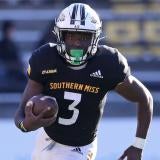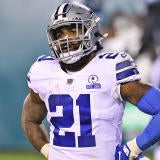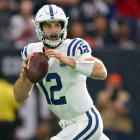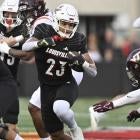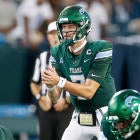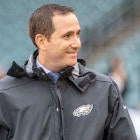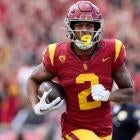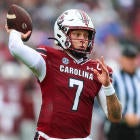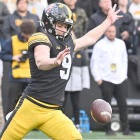The opening game of divisional weekend is a fascinating one. The paths the Kansas City Chiefs and Indianapolis Colts took to get to this point could not really have been more different, after all.
Kansas City opened the season 5-0, with the offense exploding out of the gates with record-setting performances, and the large division lead they staked themselves to early on helped maintain their playoff positioning even after a late-season stumble where they lost twice in a row. The Colts opened the year 1-5, with their offense unable to get fully untracked early on, and it was only a five-game winning streak and nine-wins-in-10-games stretch that propelled them into the playoffs, a stretch that also needed a Week 17 playoff play-in to cap it off.
The Chiefs have one of the league's longest-tenured and most respected coaches, and though they lost their offensive coordinator and changed their starting quarterback, they have a lot of the same infrastructure left over from last year's playoff squad. The Colts have a first-year coach who wasn't even their first choice, all new staffers at every position, several rookies playing enormous roles, and a seventh-year quarterback who was coming off a major injury and who nobody knew whether he would ever be the same.
But things worked out similarly for both of them. Andy Reid's decision to make the switch from Alex Smith to Patrick Mahomes worked out better than anyone could have imagined. Frank Reich ended up being the right coach at the right time and Andrew Luck ended up being just fine. So now, here we are. Chiefs. Colts. Playoffs. This should be fun (4:35 p.m. ET, NBC).
Watch Saturday's and Sunday's playoff games on fuboTV, try it for free, and stream Chargers-Patriots and all the CBS games on CBS All Access.
Colts offensive line vs. Chris Jones and the Kansas City defensive front
All week we've been hearing about how the Colts would be wise to try controlling the ball on the ground with Marlon Mack and their strong offensive line in an effort to keep Patrick Mahomes and the explosive Chiefs offense off the field. There is certainly merit to that idea.
After all, the less time Mahomes and company spend on the field, the fewer opportunities they have to score. And the Chiefs did finish the season with the NFL's worst run defense, according to Football Outsiders' DVOA. Not just that, they finished dead last in Adjusted Line Yards, which assigns credit to the offensive line based on a percentage of yards gained. They ranked 30th in Power Success, indicating that they could not get stops in short yardage situations. They ranked 27th in stuff rate, stopping only 15 percent of opponent runs at or behind the line of scrimmage. And they ranked last in second-level yards per carry, indicating that they did not do a strong job of tackling on the back end.
Who wins Colts vs. Chiefs? And what hidden stat makes one side of the spread a must-back? Visit SportsLine now to see which side of the spread you need to jump on, all from the white-hot expert who's 20-6 on Colts picks and was undefeated on Wild Card Weekend.
The Colts, meanwhile, were able to control several games with Mack beating up on defensive fronts -- even against teams with good or even elite run defenses. Mack ran for 126 yards against an above-average Bills run defense, 139 yards against the Cowboys' fifth-ranked run defense, and last week he pounded out 148 yards against the Texans' top-ranked group against the run. The Colts' offensive line was better in protection than clearing the way for runs, but it was still one of the better run-blocking groups in the league. And particularly in rookie Quenton Nelson, they have one of the better road-graters in football.
In order to ensure they're able to run the ball throughout the game and not just early on, however, the Colts have to ensure that they do not get down by multiple scores early in the game. The Chiefs jumped out to a double-digit lead inside the first 20 minutes in nine of their 16 games. They went 8-1 in those games. In the seven where they did not establish a double-digit lead in the first 20 minutes, they went just 4-3.
But keeping pace early is not just about running and taking time of the clock. You have to get some points on the board yourself. And for the Colts, that usually means going to the air. Which means they'll have to protect Andrew Luck against a strong group of Chiefs pass rushers. Chris Jones finished the season with 15.5 sacks and 29 quarterback hits, as well as 71 pressures, which ranked third among defensive tackles. As if it's not difficult enough to deal with him over the middle, there's also Dee Ford (13 sacks, 29 hits, 77 pressures) and Justin Houston (nine sacks, 12 hits, 48 pressures) to deal with on the edge. And Allen Bailey, Derrick Nnadi, Xavier Williams, Breeland Speaks and more come in waves along with them.
Of course, the Colts protected Luck far better this season than they ever have before. Luck was routinely among the handful of most-heavily pressured quarterbacks in the NFL during his first five years in the league, but this year, only five quarterbacks were pressured less often. And no quarterback was sacked less often either overall (2.7 percent of his drop backs, per Pro Football Focus) or when pressured (9 percent of pressures resulted in sacks) than Luck.
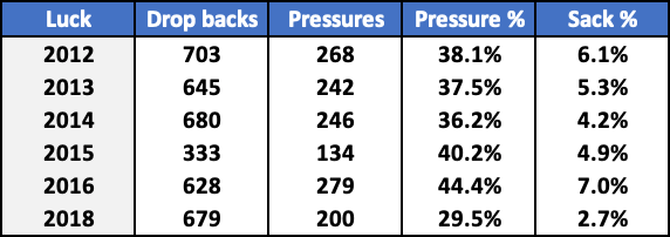
As we explored in last week's preview, Luck sped up his delivery this season, getting the ball out about a third of a second quicker than he ever had before.
According to Pro Football Focus, Luck allowed an average of only 2.54 seconds to tick on by between the snap and his average pass. That time-to-throw average was eighth-fastest in the NFL, but it was also by far the fastest of Luck's career. He had previously taken at least 2.80 seconds, on average, before throwing, in every single season of his career. And after seeing his percentage of throws that came within 2.5 seconds of the snap hover in the low-40s for most of his career, Luck threw considerably more than half his passes inside of that window this year.
Here's how that differential looks. It's quite stark:
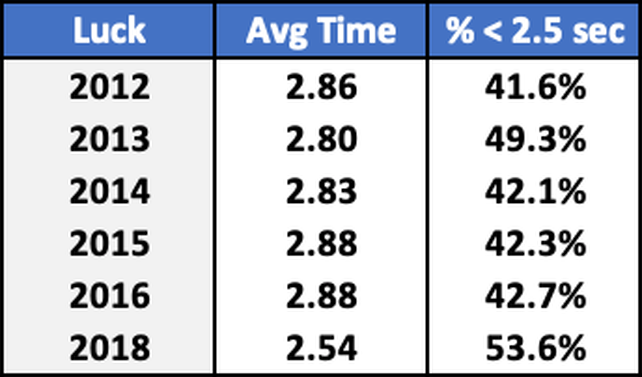
Speeding things up allowed Luck to avoid hits but also meant the offense was more often working on schedule as opposed to freelancing, which meant Luck was making schemed throws more often, and those are usually the kind that are more open. It all added up to a possible Comeback Player of the Year season, with Luck establishing career-highs in completion percentage, passer rating, and QBR. Keeping Luck protected is the single best thing the Colts did all season. It's likely to continue if they can keep the game manageable throughout, but if they get down big early, the Chiefs will be able to pin their ears back and not have to worry about the run game. And that's likely to cause the Colts a problem.
Tyreek Hill, Travis Kelce et al. vs. Colts defensive backfield
Last week against the Texans, the Colts sat in a soft zone and dared Deshaun Watson to pick them apart with precise passes fitted in between multiple defenders. Watson struggled to do so, completing 29 of 49 throws overall, for just 235 yards, one touchdown and one interception. A passer that completed 68.3 percent of his passes during the regular season completed only 59.2 percent during the Wild-Card round. A passer that averaged 8.2 yards per attempt during the year netted just 4.8 per attempt in his team's playoff loss. A quarterback who finished the regular season with 26 touchdown passes and only nine interceptions threw one of each in that game.
The Colts held DeAndre Hopkins to just five catches and 37 yards on 10 targets and Watson directed almost all of his throws to either slot man Keke Coutee (14 targets) or one of his running backs (13 targets combined). Perimeter corners Pierre Desir and Quincy Wilson did an excellent job of redirecting routes and sitting underneath the easy throws into in-between zones, forcing Watson to come off his first read and check down for short gains or fire into tighter windows than he wanted to.
It was surprising, if not necessarily shocking. Watson had a better passer rating against man defenses (106.0) than zones (100.3) during the regular season, per data from Sports Info Solutions. The same is true of Patrick Mahomes, but he's even better against both man and zone defenses than Watson.
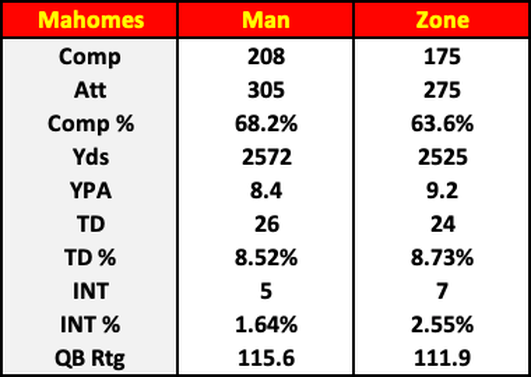
For a team that played more snaps in zone coverage than almost any team in the NFL this season, it is not necessarily a good sign that this week's opponent was so dominant against zone coverages during the regular season. Given the design of Kansas City's offense and the weapons they have on hand, it's not exactly surprising that zones could not stop Mahomes.
The Chiefs have elite vertical field stretchers on the perimeter (Tyreek Hill) and over the middle (Travis Kelce) and the Chiefs surround them with several more athletic playmakers, giving them arguably the deepest, most versatile corps of pass-catchers in the league. Hill and Kelce are each elite athletes, and the Chiefs supplement them with Sammy Watkins, Chris Conley, Demarcus Robinson, Spencer Ware, and Damien Williams. Each of those players is some combination of huge, fast, and shifty, or all three. They can all make plays with the ball in their hands, and are comfortable getting it through the air or via hand-off. They can all take a quick screen and make something happen and all of the receivers can get deep.
And the Chiefs get the damn ball deep. Mahomes threw 20 or more yards in the air on 15.9 percent of his pass attempts this season, per Pro Football Focus, the third-highest rate in the league. He was fantastic on those throws, if a bit interception prone compared to when he threw to the short or intermediate areas of the field. But that's sometimes the price you pay for the howitzer arm that can turn any play into a touchdown. And he did that quite often, tossing 15 scores on throws 20 or more yards in the air, more than any other quarterback in the NFL.
When Mahomes went deep, he was most often targeting Hill, who led the league in deep catches (20), deep receiving yards (754), and deep receiving touchdowns (seven) while also posting the second-highest catch rate among the 20 wide receivers with 20-plus deep targets. Kelce, meanwhile, led all tight ends in deep catches (nine) and deep receiving yards (243) while ranking second in deep-ball touchdowns (two), behind only Eric Ebron.
Having that duo stretch the field vertically opens up all kinds of crossing patterns and mesh routes and smoke screens and release valves underneath, which Mahomes was happy to take when they were available to him. He has the arm talent to fire the football into the tightest windows imaginable, but he almost never had to: only 12.2 percent of his passes were thrown into tight windows, per the NextGen Stats on NFL.com. That was the single lowest figure in the NFL among regular starters. (Only Brock Osweiler and Nick Mullens had better figures, but Mullens threw less than half as many passes as Mahomes and Osweiler only started five games.)
Andy Reid schemed Mahomes into a ton of layup-type throws that had extraordinarily wide windows, allowing him to hit his man in stride so that the Chiefs' various speedsters could make hay after the catch. The Chiefs' pass-catchers created 2,530 of Mahomes' league-high 5,097 passing yards after they'd caught the ball, a rate of 49.6 percent. Among 30 qualifying quarterbacks, only seven had to create a lower percentage of their yards in the air as opposed to with the ball in their receiver's hands.
So the Colts' defensive backfield has to not only prevent all these dynamic players from getting open, but be sure to wrap up and tackle as soon as possible once they do. Of course, that's easier said than done. Especially against these guys.
Prediction: Chiefs 34, Colts 24








